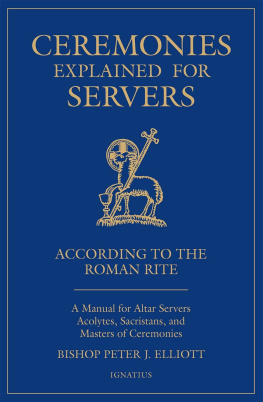CEREMONIES EXPLAINED FOR SERVERS
PETER J. ELLIOTT
Ceremonies Explained for Servers

A Manual for Servers, Acolytes, Sacristans, and Masters of Ceremonies
Illustrations by Clara Fisher
IGNATIUS PRESS SAN FRANCISCO
| Nihil Obstat: | Rev. Gerard Diamond MA (Oxon), LSS, D. Theol |
| Diocesan Censor |
| Archdiocese of Melbourne |
| Imprimatur: | Very Rev. Joseph Caddy, AM, Lic Soc, E.V., P.P. |
| Vicar General |
| Archdiocese of Melbourne |
| August 16, 2019 |
The Nihil Obstat and Imprimatur are official declarations that a book or pamphlet is free of doctrinal or moral error. No implication is contained therein that those who have granted the Nihil Obstat and Imprimatur agree with the contents, opinions or statements expressed. They do not necessarily signify that the work is approved as a basic text for catechetical instruction.
Cover design by Roxanne Mei Lum
2019 Ignatius Press, San Francisco
All rights reserved
ISBN 978-1-62164-299-2 (PB)
ISBN 978-1-64229-102-5 (eBook)
Library of Congress catalogue number 2019931423
Printed in the United States of America
Mariae Matri Filii Sui Servorum
Contents
Foreword
Good serving is more than following rules or being correct or learning to adapt. It is a sacred duty.
With these words in the preface to his Ceremonies Explained for Servers, Bishop Peter Elliott succinctly states the great value and need of the book you are holding in your hand. As the West continues to drift farther away from a sensitivity to the divine, it is more urgent than ever that the Church do all in her power to recover a sense of the sacred. In this effort, the old adage is true: Little things mean a lot.
In explaining ceremonies for servers, Bishop Elliott does, indeed, offer very clear and detailed explanations of all the varied actions servers perform in a way that is easy to understand and to follow. But this volume offers far more than instructions. His Excellency delves deeply into the theology of the Mass as well as such subjects as the meaning of liturgical symbols, from material objects to time. The practical advice he offers in what might seem mundane matters (such as cleanliness and good grooming) underscores the reality that in the worship of Godand all the more so for one who has a leadership role in itno detail is unimportant, for we owe our best to God in everything. Recognizing that any role in liturgical leadership cannot achieve its goal of lifting the minds and hearts of Gods people to an encounter with the divine without it flowing from a deep spirituality, he also weaves throughout his explanations of the rites of the Church exhortations to altar servers to develop the proper spiritual disposition toward the sacred liturgy, even including an appendix of recommended prayers specifically suited to servers.
We can say, then, that the approach Bishop Elliott takes in his explanation of serving at the liturgy is one of formation, not simply training. Indeed, his approach reflects the four dimensions of priestly formation: human formation in the practical advice that he gives in regard to more mundane, but nonetheless important, matters; intellectual formation through his teaching about the theology of the Mass and the meaning of liturgical symbols; spiritual formation through the prayers he suggests and by highlighting the spiritual disposition a server must have; and pastoral formation in the sense of the detailed instructions he gives for all of the actions a server must perform. Formation is, ultimately, exactly what is needed for the whole people of God to be renewed in a sensitivity to the sacred, and a sensitivity that must first and foremost be modeled by the ministers at the altar.
This latest work of the renowned Australian liturgist and prelate is timely, needed, and comprehensive, including explanations on serving all forms of liturgical services far beyond the Mass, such as weddings, funerals, and Exposition of the Blessed Sacrament. Bishop Peter Elliott has done a great service for the Church, and I pray that this book will be widely read and implemented in parishes all throughout the world so that it may become a catalyst for authentic liturgical renewal in the Church. Serving God well in the liturgy is, indeed, not simply a matter of following rules correctly but, above all, a sacred duty.
Salvatore Cordileone
Archbishop of San Francisco
Preface
A large portion of this book first appeared as Ministry at the Altar (Sydney: E. J. Dwyer, 1980). In the intervening years, there have been many requests for a new edition and not a few developments in the liturgy. Therefore this new book, Ceremonies Explained for Servers, not only incorporates these changes but can be used in conjunction with my other works, Ceremonies of the Modern Roman Rite (San Francisco: Ignatius Press, 1995, 2005) and Ceremonies of the Liturgical Year (San Francisco: Ignatius Press, 2002). In the light of the provisions of Pope Benedict XVI in Summorum Pontificum (2007), directions are included for serving Mass according to the Extraordinary Form, described in this book as the traditional Latin Mass.
In this detailed and comprehensive guide for servers, careful attention has been paid to the directives of the Church. These have been interpreted with a blend of practical common sense and pastoral reality. In light of the continuity of our tradition, sound customs have been maintained and high standards and ideals are promoted to enrich our worship. Good serving is more than following rules or being correct or learning to adapt. It is a sacred duty, the worship of God, acted out in the ways the Lord has inspired within his Church. It is a noble Christian art.
I hope that this book will encourage servers to value and enjoy serving. To make this possible, explanations of sacraments, ceremonies, and customs have been included. If we know what something means and why we do it, we assist with greater understanding and reverence and we can carry out our duties easily and well.
This book incorporates the work of a group of dedicated people who were inspired by the ideals of the Australian Guild of Saint Stephen. They proposed the details, points, and procedures included in Ministry at the Altar. In preparing this new book, Ceremonies Explained for Servers, I thank Thom Ryng, not only for his technical assistance but for sharing ideas from his own Altar Servers Training Manual. I also thank Rev. Msgr. Gerard Diamond for scholarly guidance on the role of the Levites.
In offering this guide to servers, acolytes, M.C.s, sacristans, and clergy, I would ask for a little patience! To describe a ceremony accurately may take ten times as long as actually carrying it out.
Most Rev. Peter J. Elliott
Titular Bishop of Manaccenser
Auxiliary Bishop Emeritus, Melbourne
1.
The Server
You are a server. As you assist the priest, who leads the worship of the Church, so you make Catholic worship more reverent, efficient, and beautiful. Your work for God is very important, and this manual is designed to help you.
At the altar, your service is directed firstly to God, secondly as help to the clergy, and thirdly as assistance to the people who have been gathered by God for worship. Your actions are visible. You appear in public, but you are never a performer. By your faithful duty, you remain always a servant of Jesus Christ in the community of his Church.
Next page










